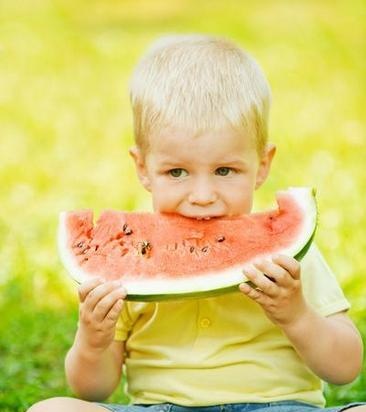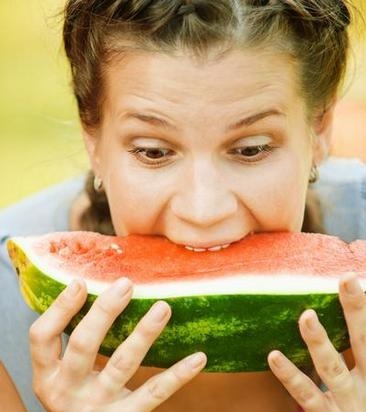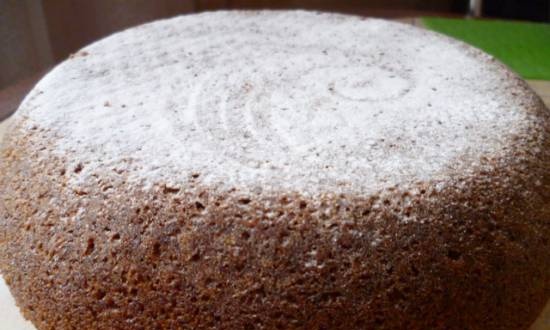|
 From the time of Tsar Alexei Mikhailovich to the present day, melon growers have been tormented by one unresolved question: how to make watermelons transportable? How to transport them without loss? Tsar Alexei Mikhailovich was a great sweet tooth. From the time of Tsar Alexei Mikhailovich to the present day, melon growers have been tormented by one unresolved question: how to make watermelons transportable? How to transport them without loss? Tsar Alexei Mikhailovich was a great sweet tooth.
They brought him the sweetest watermelons, from Astrakhan. In carts, on horseback. To prevent the fruits from cracking on the way, they hung them on belts. Moreover, pillows were attached to each watermelon so that they would not bump against each other. Then they began to carry on carts with springs. Melon growers claim that the springs themselves appeared from the need to transport whimsical watermelons. They checked: one mile of driving without springs does them more harm than a thousand miles with springs.
Now we carry it smoothly, on rails, but ... loading, unloading, transferring. From carriage to carriage, to car, from car, to store ... Sometimes the third part will be beaten. What to do? Breeding unbreakable varieties? The idea is correct. But here's what history says. Once on the Volga, two varieties were famous - Rastun and Treskun. Rastun grew quickly and tolerated transportation well. It was being prepared for sale. And they raised Treskun for themselves. This one split from the slightest jolt. It could only be eaten on the spot. But he was three times, ten times more tender, tastier, sweeter than Rastun.
 We struggled for a long time with the problem: how to determine the strength of a watermelon? How to find out in advance whether the product will reach the buyer or not? We struggled for a long time with the problem: how to determine the strength of a watermelon? How to find out in advance whether the product will reach the buyer or not?
They put the watermelon under the press. If the bark bursts, it means that it is not suitable for a long journey.
Then another method was developed. Cut a strip out of the watermelon bark. Slice. Narrow and long. We tried to bend it into a ring. The steeper the arc, the stronger the crust. The bark itself was taken apart in layers. Its strength is given by a layer of mechanical fabric. Springiness is that colorless layer that we do not gnaw and throw into the trash with the bark. If you could strengthen these layers? Have tried. The watermelon is still cracking. It's not just the bark.
Also in the pulp and much more.
In general, so far there is no such grade that does not crack. Nature has programmed striped balls for just the opposite. The watermelon can roll for a while, but it should crack at the finish line. Otherwise, how will the seeds spill out on the wild melons? Now the program is being executed ...
Breeders will have to tinker a lot. The watermelon business is new.
In Russia, large melons appeared only a hundred years ago - in the 80s, when a railway was built from Moscow to Saratov and Tsaritsyn. It was then that the watermelon era began. The center of the new empire was the village of Bykovo on the Volga, about 80 miles below Kamyshin (there is a watermelon center to this day). The scale of watermelon cultivation among the Bykovskaya villagers was amazing. In one autumn day, they loaded a million heavy fruits! The technique was developed excellent. We did without any chemistry. There were, of course, their own secrets. The main thing is in the seeds. They did not take them from any fruit.
Of the special ones, which were called watermelons. Cut the watermelon in half. Seeds were selected only from the half that is closer to the "tail", to the stalk.
Of course, any secret doesn't last forever. The neighbors adopted the experience of Bykovites. And soon the Volga shores turned into a huge stadium, where millions of green balls are scattered. However, the watermelon saga ended rather poorly. They prepared so many fruits that they could not transport. Piles of fruit have accumulated at the stations.
Countless hordes of watermelons rotted under the Volga sun. Beautiful, healing, but, alas, inaccessible to the consumer.
However, a way out of the difficult situation was found. Thanks to the Free Economic Society. It accurately foresaw the watermelon crisis and back in 1810 announced a competition for the extraction of sugar from watermelon juice. Nobody then succeeded in this task. But honey was cooked. Dark, thick nardek. They kneaded dough on it and baked gingerbread. Experts say that there can be no better gingerbread in the world.After the revolution, Moscow cooperators became interested in the people's commissar. They bought watermelon honey in wagons. They were sent abroad. Especially a lot of it was bought by German firms from the city of Hamburg. They also baked gingerbread.
Having heard about Bykov's watermelons, the Americans equipped a special expedition to the Volga. We wandered around the melons. We tasted it. The best varieties were selected. Collected seeds. Then they divorced them in the States. Russian watermelons differed from their own, home-grown, unprecedented keeping quality. Could be kept until Christmas. Therefore, they were dubbed "Christmas". And the Don Cossacks developed an even more stable variety. Pudova, Azovsky. With pale yellow flesh and blue seeds. It could be stored all winter. And although the pulp was not very sweet, there was still no price to the variety. Excellent candied fruits were made from it, and the plant could work all year round without interruption.
 We in Russia were not particularly fond of sizes (the larger, the more watery). There was such a not very large watermelon - the Favorite of the Pyatigorsk farm. The owner of the farm D. Lesevitsky, known throughout the country, brought him out. The Pet had fiery red pulp. It matured so early that it was suitable even for Eastern Siberia. I kept up excellently there, despite the short summer. Since then, many varieties have changed and disappeared into oblivion. The beloved is all alive! We in Russia were not particularly fond of sizes (the larger, the more watery). There was such a not very large watermelon - the Favorite of the Pyatigorsk farm. The owner of the farm D. Lesevitsky, known throughout the country, brought him out. The Pet had fiery red pulp. It matured so early that it was suitable even for Eastern Siberia. I kept up excellently there, despite the short summer. Since then, many varieties have changed and disappeared into oblivion. The beloved is all alive!
Sowing has always been considered the most difficult in the watermelon business. The fat seeds attracted a lot of birds. In the spring, melons are like a bird market; pigeons, crows and poultry are huddled together. Mice, of course, too. Those owners who were stingy and pitied the seeds punished themselves. The four-legged and the birds ate everything clean. A new sowing had to be done. But time has already passed. More savvy melon growers paid tribute to the beast. Not one seed was thrown into the hole, not two or three, but twenty, or even a whole handful. As a result, both sides won.
In the United States, earthen hares are particularly annoying to this day. We tried to sprinkle the seeds with mothballs to fight off the watermelon smell. It helped, but only on condition that the crops were clean and the sowers left no traces. If you have lost even a few grains, everything is lost. Hares are no longer afraid of naphthalene. On the contrary, they tend to smell like maniacs.
Even die-hard anti-vegetarians like wolves are attracted to watermelons. We saw a wolf, which neatly visited the melon for sweets. “He will hit him with his muzzle and roll to the log.
I threw it off the cliff, another rolled. In the morning I found some skins ”, - V. Peskov testified. Thus, the attitude of the wolf to watermelons is quite human. Gray likes, just like us, juicy, sweet pulp.
The hare is a different matter. He has a completely opposite concept of watermelons. You can't seduce a hare's pulp. Give him a crust. Exactly the one that we and the wolves throw away. Oblique gnaws a striped ball outside, greens to a white layer. Then they drop it and go to the next one. A white spot on a green background is visible from afar. It catches the eye of rooks and hooded crows. The place is vulnerable, it is easy to gouge it with a beak. The birds do just that. Make a hole. Get to the pulp.
Then they throw it away, and the fruit rots under the generous sun.
If it were not for the hares, the crows would not have dared to act independently. Shoot obliques? No you can not.
Summer. And the law is on their side at this time. The melon growers were not embarrassed by the difficult situation. They launch an ordinary kite into the sky. And they themselves walk across the field with a short-legged dog. The dog scares away the hares. They see a serpent in the sky. And he, probably, seems to them as a hovering predator, because the slants ask such a snatch that they instantly free melon. Then they are not visible for half a day. Only in the afternoon, in the evening, do they appear. Then the melon grower launches the snake again and goes to the second round.
Another difficulty with watermelons is picking up land. The virgin land has always been considered the most suitable for them. When the virgin lands diminished, the watermelon craftsmen were alarmed. It came to curiosities.In the Poltava province, virgin lands began to be sold at retail, in buckets and wholesale - at 50 kopecks per cart! They drove for tens of kilometers, poured into holes in the field. And at the beginning of the century, even a message in the press flashed: from now on there are no large melons in the Poltava region! What to do? The population has grown, and there are fewer vacant areas. The watermelon whip requires space ...
If it was so bad with the land in the Poltava region, then what to say about the north.
 There are very few convenient sites. Especially on the rocky island of Valaam. At one time the monks tried to grow their own, Valaam watermelons. They brought out the Monastyrsky round variety, black to black. At first everything went smoothly. Then the fruits began to shrink. And the taste has changed. The main gardener, hieromonk Anastasiy, turned to the magazine: "What is to be done?" - "Get some fresh turf land!" Was the answer. “But we have only rocks on Valaam ...” - “Well, go to the mainland and bring the land by boat,” retorted the magazine. There are very few convenient sites. Especially on the rocky island of Valaam. At one time the monks tried to grow their own, Valaam watermelons. They brought out the Monastyrsky round variety, black to black. At first everything went smoothly. Then the fruits began to shrink. And the taste has changed. The main gardener, hieromonk Anastasiy, turned to the magazine: "What is to be done?" - "Get some fresh turf land!" Was the answer. “But we have only rocks on Valaam ...” - “Well, go to the mainland and bring the land by boat,” retorted the magazine.
Perhaps, the Kashmiris got out of the land deficit in the most original way. They break melons not among the sandy steppe, but among the water. We chose for this purpose the most beautiful lake of the Kashmir Valley - Zerinatur, one and a half kilometers long. Poplar poles, long as logs, are driven into the bottom. Rows, rows, five steps from the row. Then the tenacious water grasses are dragged out of the water and the poles are fastened like a rope. It turns out something like a hammock. More aquatic herbs are piled on the hammock. They decompose quickly and the ridge is ready. Watermelons grow on it perfectly. The crops are harvested by boats.
And finally, I foresee the question: how to evaluate the ripeness of a watermelon? How to choose red, juicy, sweet? In order not to be soggy or overripe? Connoisseurs approach this issue with caution. Discreetly. It is usually advised to evaluate a future purchase from three sides. First, is the tail dry? If dry, the watermelon is ready. The more meticulous ones recommend paying attention - is it twisted? Better to take not twisted. Second rule: click on the skin with your fingernail. If the sound is ringing, take it. If you are deaf, wait. The third rule: look at the bright spot (on the side that was to the ground). If it is shiny, smooth, it is bad. If it's bright yellow, good. If it's rough, good. If it's barely whitish, it's bad.
But all these rules do not yet provide a guarantee. You can click and get a resounding answer, but inside there is emptiness! Overreached! Some try to squeeze the watermelon. If it bursts, it is considered ripe. But this is how to compress! If there is strength, anyone will crack! Even the most unfit one.
Perhaps, the commentator of one of the old agricultural magazines spoke best. “Finding out whether a watermelon has sung or not is, pardon the comparison, as difficult as distinguishing a young gander from a goose. An experienced owner will not be mistaken, but ask, by what signs he learned this - he will not be able to say! Intuition!"
A. Smirnov. Tops and roots
|
 From the time of Tsar Alexei Mikhailovich to the present day, melon growers have been tormented by one unresolved question: how to make watermelons transportable? How to transport them without loss? Tsar Alexei Mikhailovich was a great sweet tooth.
From the time of Tsar Alexei Mikhailovich to the present day, melon growers have been tormented by one unresolved question: how to make watermelons transportable? How to transport them without loss? Tsar Alexei Mikhailovich was a great sweet tooth. We struggled for a long time with the problem: how to determine the strength of a watermelon? How to find out in advance whether the product will reach the buyer or not?
We struggled for a long time with the problem: how to determine the strength of a watermelon? How to find out in advance whether the product will reach the buyer or not? We in Russia were not particularly fond of sizes (the larger, the more watery). There was such a not very large watermelon - the Favorite of the Pyatigorsk farm. The owner of the farm D. Lesevitsky, known throughout the country, brought him out. The Pet had fiery red pulp. It matured so early that it was suitable even for Eastern Siberia. I kept up excellently there, despite the short summer. Since then, many varieties have changed and disappeared into oblivion. The beloved is all alive!
We in Russia were not particularly fond of sizes (the larger, the more watery). There was such a not very large watermelon - the Favorite of the Pyatigorsk farm. The owner of the farm D. Lesevitsky, known throughout the country, brought him out. The Pet had fiery red pulp. It matured so early that it was suitable even for Eastern Siberia. I kept up excellently there, despite the short summer. Since then, many varieties have changed and disappeared into oblivion. The beloved is all alive!








































